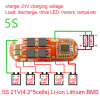SentinelAeon
Member
Well if you look at the last battery, its connected directly to + of the DC source. So basicly, it can never stop the charging of that battery, the way i see it. What am i seeing wrong ?
Follow along with the video below to see how to install our site as a web app on your home screen.
Note: This feature may not be available in some browsers.
Well if you look at the last battery, its connected directly to + of the DC source. So basicly, it can never stop the charging of that battery, the way i see it. What am i seeing wrong ?

I am not sure i am following. Would that mean that as soon as 1 battery is over 4.2V, charging will stop for all of them ?
Genuine electronic parts are inexpensive and can be bought locally from a reputable distibutor. The parts work properly.The reason i am buying things from ebay is that i am on a budget.
Genuine electronic parts are inexpensive and can be bought locally from a reputable distibutor. The parts work properly.
The Li-PO batteries in electric radio controlled model airplanes do not have protection boards. They are charged with a multi-wires balanced charger and the electronics in the model limits the maximum discharge current and cuts off the high current motor when the total voltage drops to 3.2V per battery cell but leaves the low current radio receiver and servos operating so the model can be controlled while gliding in for a landing.
Like i said, beside BMS, i will add temperature and current fuse. But yes, i understand the problem. I am wondering, overcharge (voltage over 4.2V). Why does the battery explode ? Does it heat up or not during that charge to high voltage, for instance 4.5V.
Forget about bms wires, i ordered different bms altogether. Could you tell me why 5V power suply has to be seperated for each board and why cells cannot be in series when i charge them individualy ? It seems there are no simple solutions ..

